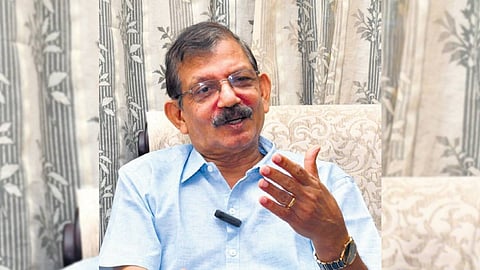

KOCHI: As the state is slowly coming to terms with the capsizing of a Liberian-flagged container vessel MSC ELSA 3, retired Merchant Navy chief engineer Joseph Malcolm Oliver recalls how he had a miraculous escape after his container ship split into two off the Japanese coast after being caught in a typhoon and he was left floating in the rough sea for hours before being washed ashore in an island.
“Container ships are the most vulnerable in rough weather. It (the incident) happened in July 2002. I was then the chief engineer of the vessel M/V Co-op Venture, a Panamanian-registered cargo vessel. We were unloading cargo at the port. Then the authorities suddenly gave a tropical storm warning and asked us to take the vessel a little away from the port. We soon anchored near to the bay and there was no time and fuel to move to other safer locations,” recalled 68-year-old Joseph, who had worked in large container ships, including those in the 20,000 TEU.
The typhoon ‘Fengsten’, that ran aground off Shibushi Bay, located off the south west main island of Kyushu, 985 kms south west of Tokyo, soon began to lash the area. There were strong winds from 4 pm onwards. Then the unthinkable happened. The ship was caught in huge waves and split into two by 8 pm.
“As per the captain’s direction, we ran to the LifeBoat station and got into it. As the boat was being downed using two cable wires, it began to swing harshly in the high-speed winds, blowing at 165 kmp. It hit the ship hull with a thud several times. I felt like my bones were cracking and was in extreme pain. But then the face of my younger son, who was only one-year-old then, popped up in my mind and I decided to fight till my last breath,” Joseph, who earlier had a stint with the Shipping Corporation of India (SCI) for 13 long years, added.
There were 21 crew in the ship, of which 16 were Filipinos. “I was the only Malayali. I saw the Filipinos jumping into the sea and I followed suit. We’d all worn life jackets. There was virtually no scope of saving lives as the lifeboat was swinging wildly and repeatedly hitting against the broken ship hull with terrific force.”
By then the oil, due to the bunker spill, had spread all around the ship. “Nearly 2000-tonnes of oil had spilled into the seawater and we were all covered with oil. We were repeatedly caught in whirlpools and spinning like clothes inside a washing machine. I could hear the cries of people. I saw the lifeboat floating beside me and grabbed it, as it gave chance of survival. But my leg got tangled in the rope and the high wind and monster waves threw me around with my head and all hitting the debris,” Joseph went down memory lane.
With one last effort, Joseph managed to free himself and was swept away by the undercurrents, which was taking him deeper into the rough sea. He began to float around with the life jackets and had no idea where he was heading to as it was darkness all around.
“I fell into the sea by 8 pm and by 2 am, my legs touched something beneath. To my surprise, there was sand below. I realised that it was an island in the sea. It was raining heavily and I lay there on the beach, thanking all my stars. The Japanese Coast Guard arrived later and rescued me,” Joseph, who is residing at South Panampilly Nagar, said.
He underwent treatment for head, hand and leg injuries for months altogether. But the incident couldn’t douse the sailing passion in him.
“The next day after he reached back, he told me he would return to the job as quickly as he can. The incident didn’t shake his passion or confidence,” adds wife Jemma.
And Joseph joined another shipping company ‘Fleet Management’ where he worked for another two decades till 2022. Even now, he associates with the field, taking classes in ‘Ship Technology’ at various institutes like Cusat.